| |
8/7/11
Two more excellent letters
The following letter, by local resident Lowell Garner, was published in the Ithaca Times on July 27.
 Upset with deer editorial, question Upset with deer editorial, question
I would like to make the following comments concerning the June editorial entitled "Oh Brother Deer, Where Art Thou?" The poll that accompanies the article is insulting to any thoughtful person. You offer two horrific choices for dealing with the deer-human conflict: "net and bolt" (trapping and brain penetration with a steel bolt) or starvation.
Those who have objected to the Village of Cayuga Heights' (VCH) plan do not propose either as possible alternatives. Why not provide viable options cultivated from sound science rather than myth? Your editorial and a subsequent letter posted last week perpetuate the myth that mass starvation of deer in our area is inevitable or has occurred in the past, respectively. Not true. Another you imply is that Chronic Wasting Disease (CWD), otherwise known as Transmissible Spongiform Encephalopathy, is caused by a nutritional deficiency. Also not true. CWD is caused by an infectious agent, hence the word "transmissible." And this agent, according to the DEC, is not even active in New York State. The fact of the matter is that we have created a fragmented landscape, the ideal habitat for these animals to flourish.
Last winter was particularly cold. There were frequent storms and we saw prolonged snow cover. Yet did we see the 200 or so bodies our local experts have "estimated" strewn across peoples' property because the current carrying capacity has been exceeded? No. Fawns were sighted as early as the second week of May and several bucks exhibited advanced antler growth. Both are considered signs of adequate nutrition throughout the winter. I am hopeful that this will alleviate the sentimental concerns for death by starvation expressed by the authors. But then of course there is the concern that an effectual fencing policy designed to protect ornamental plantings, which is at the heart of this controversy, would reduce the available food. No need to despair here! VCH will not enact one. And if by chance the Village were to do so, I have a sneaking suspicion that the hungry deer might be "intelligent" enough to leave to find more abundant food in the surrounding areas rather than just stand in the road. The hunters and farmers that I have spoken to, albeit a nonrandom sampling, will tell you there is not an overabundance of deer out in the country. Please remove this nonsensical ballot designed to promote a distortion of the truth from your web page.
As for "Victorian sentimentality," I personally object to the use of this phrase. Is it sentimental to allow sentient beings with all the same physiologic pathways for pain as humans, or even our beloved dogs, to be brutally terrorized by our actions? Is it sentimental to wonder, after several acres of formerly lush habitat have been clear-cut, what is going through a bewildered fawn's mind as she stands in the middle of the expanse? (Hint: "Where did my hiding places and my food go?") I assume that this is deemed acceptable because it was done by man's machines rather than by deer's mouths. But keep in mind that, sadly, I bet one or two mid-canopy songbirds we all worry so much about, were unfortunate enough to have chosen this lot to nest and also no longer have a home.
No, my basis for objecting to the kill plan is based upon my understanding of neurophysiology, ecology and the ways of the white-tail deer rather than "Victorian sentimentality;" and yes, my sense of morality. It is also based on overwhelming evidence. The evidence being that man is by far the most destructive and arrogant species this planet has ever known. Must we kill another species to remove from view our own sins? Are we not yet aware of the intricate and beautiful interconnectedness of all life forms? Mankind's meddling, such as current efforts in Idaho and Wyoming to once again eradicate the wolf, has repeatedly led to unintended consequences. Not a coincidental example I offer, considering your solution to "the deer problem" is to restore the true balance of nature by reintroduction of top predators. You and I both know that when the first "Princess" or "Fido" disappears, there would be a righteous call to a shoot-on-sight campaign.
No, "true progressivism" does not find its basis in sentimentality but rather in truth. The deer, whose eyes I have looked through as you have suggested to do, have an innate understanding that net and bolt is an atrocity. They have evolved over thousands of years to survive both the scarcity of winter and the appetite of the wolf. But they don't stand a chance against the net and the bolt.
The following letter, by local resident Mary Williams, was published in the Tompkins Weekly on July 25.
 Reconsider Violent Deer Control Plan Reconsider Violent Deer Control Plan
Deer have lived in our area much longer than humans have. Elk and bison were also once native to New York State. The last bison in the northeast was shot in 1825, and the last elk in the region was killed in 1867. I am thankful that whitetailed deer have survived here as long as they have.
The Cayuga Heights board members, in planning to order the mass trapping and slaughter of does, fawns and bucks, show arrogance, ignorance and hatred toward this ancient species. Ironically, Cayuga Heights was originally advertised as a community “for those whose hearts are attuned to the most beautiful things in nature,” according to developer Jared T. Newman’s 1921 real estate brochure.
Not everyone grows up with a respect for wildlife. Many of us have never had the chance to learn about wild animals up close, gain an understanding of their behavior, or learn to love them as fellow residents. It is then imperative that community leaders, especially when planning to basically eradicate a species from an area, reach out, or at least open their minds, to those who can teach them about our local wildlife. The trustees have ignored experts from major universities who have found much fault with the net-and-bolt slaughter plan.
It is time for the Cayuga Heights board of trustees to step back, and stop their violent plan before it goes any further. Ithaca should not be a place where people slaughter wild animals just because we do not understand them. We would all be affected by the violence, suffering, and sadness inflicted on both the deer and human community if the trustees proceed with their plan.
6/19/11
Three more excellent letters!
This past week, three additional letters appeared in the local papers supporting the effort to stop the Cayuga Heights deer-killing program:
 Deer 'slaughter' not compatible with area Deer 'slaughter' not compatible with area
Ithaca and regions are beautiful. Activities are plentiful. Cornell University and Ithaca College provide an active, multicultural environment. These factors and many other attractive elements are the reasons Ithaca often ranks high as a desirable place to live.
But at the other end of this spectrum, there's the net-and-bolt slaughter of the local deer in Cayuga Heights. It doesn't fit the picture as something that diverse, progressive, educated people would even consider. Yet, it is what the village trustees intend to do.
I saw a video clip of net-and-bolt being carried out and was absolutely horrified that human beings would deliberately inflict suffering and death on these animals in such a cruel, inhumane manner. It's simply not justified! The trustees are urged to reconsider and reverse this awful plan. As Mahatma Gandhi said, "The greatness of a nation and its moral progress can be judged by the way its animals are treated."
Marguerite Raponi McCartney
Ithaca
 Deer plan a bad idea for Cayuga Heights Deer plan a bad idea for Cayuga Heights
I attended the recent meeting in Cayuga Heights in support of the lawsuit to stop the plan to "net and bolt" Cayuga Heights deer in the hundreds.
I am 75 years old, a property owner (71 acres) in Danby for 50 years. We share fields, woods and water with several herds of deer displaced by developers. Our vegetable and flower garden is fenced and we have never been troubled by deer browsing nearby. We are appalled by the planned brutal mass killing of deer.
Hunting for our food may be one of the "natural laws" but nature's laws are not license to kill in order to "preserve" privileged neighborhoods.
The ordeal of civility is increasingly fragile in this country and some communities believe that their "gates" are invisible. The meetings we have attended for months reveal the gates of Cayuga Heights and just whom they protect. Sensible, sane fences and laws about them enable human gardeners to protect their abundance and also respect the foraging needs of our fellow creatures.
We share this earth and murder fellow creatures for "civilized" isolation at our peril. The "net-and-bolt" plans are infectious; they can spread. Let's stop it now.
Sarah Elbert
Danby
 Cayuga Heights’s deer plan “disgraceful” Cayuga Heights’s deer plan “disgraceful”
Why do so many humans have no empathy for other creatures? Wild animals have exactly as much right to live free lives as humans do. Should any government agency have the right to kill or sterilize people? Of course not, we would scoff at that or be outraged. So why do we even consider it for deer or other animals?
The proposed Cayuga Heights slaughter of the Village’s beautiful deer near human homes is disgraceful and without any true rationale.
Residents who care more about their landscaping than precious living beings have no shame. So the deer eat your plants — so what? We humans have dangerously depleted the world’s fish population, have poisoned the air and water, and genetically ruined much of the world’s natural crops — far worse damage than deer eating your begonias. Should we be exterminated? Either put up better fences or stop whining. Killing is simply immoral.
Similarly, the DEC’s plan to trap the deer and drive steel bolts into their brains is sadistic barbarity. Veterinarians agree it is a particularly cruel method. How can anyone with a heart commit this atrocity?
If anyone thinks killing deer will decrease Lyme disease, they do not know real science on that point. Likewise, biodiversity is affected by deer not one tiny fraction as much as humans harm it. Nor is “over-population” an excuse for hunting deer, as the DEC and other hunting-lobby-beholden agencies manipulate the population for their own purposes, and besides, hunters don’t do what nature does, i.e., kill the weak. No, they want to feel macho so they kill the healthiest, largest members of a herd.
For one moment, put yourself in the place of the innocent deer. Now, how can you agree to murder them?
Eileen Fay
Saugerties, NY
6/12/11
Op-Ed: Heights plan a brutal way to deal with deer control
 An opinion piece was published in the Ithaca Journal this week, written by Elizabeth Root, who efficiently hits on key points that are driving the Cayuga Heights deer controversy, and eloquently explains why a new approach is needed: An opinion piece was published in the Ithaca Journal this week, written by Elizabeth Root, who efficiently hits on key points that are driving the Cayuga Heights deer controversy, and eloquently explains why a new approach is needed:
Very early one recent morning, two deer approached the water's edge of Seneca Lake. Human observers, from a lodge balcony, were captivated when the pair waded in and went swimming. The deer circled back to shore and disappeared into the brush.
Wildlife observers know that species other than humans appreciate the beauty of their surroundings; they play, even as adults; and they have sentient feelings for one another. Their love of life equals ours. Hence, deer killing is repugnant to many humans.
Bitter division grows in Cayuga Heights and the surrounding community over the unanimous decision of that village's board of trustees to kill all estimated 200 deer in the village, except for about 20 does that will be sterilized. Net-and-bolt killing is to occur annually, sparing only these sterilized does, because other deer move in to replace the dead.
Cayuga Heights resident Ann Druyan, writer/producer of science media, asked several independent experts on wildlife management, ecology, biodiversity and Lyme disease to evaluate the trustees' plan. They characterized the village's environmental review as "deeply flawed" and "misleading," and they noted that the plan lacks any basis in Cayuga Heights-specific data. They identified invalid scientific arguments, for example, that killing deer would reduce the risk of Lyme disease in Cayuga Heights, or that deer are responsible for diminishing biodiversity in an environment so heavily shaped by human activity.
Druyan and 11 other area residents have filed a lawsuit challenging this Cayuga Heights plan. Aesthetic and humane aspects weigh heavily into the controversy. Net-and-bolt killing is brutal. Groups of deer are captured in a net, causing panic, injuries, even death for some. Immense suffering is incurred. Shooters inject steel bolts into the heads of surviving captives. This happens in proximity to residences. Net-and-bolt killing is designed for densely populated areas because it doesn't endanger humans, as would bullets.
The human toll includes asperity, pitting neighbor against neighbor. Many support the logical solution of changing village sanctions to allow higher fencing to protect gardens. Trustees discussed this at their May 9 meeting, which I attended. The objection was that even transparent fencing would spoil the village's appearance.
It's hard to comprehend their priorities when the horrible suffering of animals is at stake. Increased acrimony will result from the trustees' plan.
New Jersey gained notoriety for its net-and-bolt practice. A national organization, including more than 10,000 N.J. citizens, is lobbying the governor to ban the program, describing it as "unreasonable, ineffective, and grotesque." Does Cayuga Heights really want to be first in New York to initiate abhorrent killing?
I entreat the Cayuga Heights trustees to reconsider. There is no shame in reversing a decision gone wrong.
 6/4/11 6/4/11
Four letters of support in the Ithaca Times
Here are some excerpts from recent letters to the editor supporting the effort to stop the deer-killing plan in Cayuga Heights:
Cayuga Heights concern from across the pond
The members of Quaker Concern for Animals in Britain have supported the defenders of the Cayuga Heights deer since the beginning of their campaign and would like residents to know that we endorse their initiating a lawsuit to protect the animals.
We share their wish to defend the values so many hold dear, especially integrity, compassion and non-violence, all of which accord with Quaker testimonies.
Cannot a more enlightened way be found to resolve this conflict? The protection of garden plants should surely not acquire more importance than the lives of gentle, defenceless creatures who, themselves, wish us no harm.
—Marian Hussenbux
Arrowe Park, Wirral, Britain
 Deer-killing plan puts Cayuga Heights in negative light Deer-killing plan puts Cayuga Heights in negative light
I saw a news story about the Cayuga Heights backyard deer-killing plan on “Issues with Jane Valez-Mitchell” and have been following this issue ever since. This national attention has put Cayuga Heights in a very negative light.
The trustees have decided to kill the deer in neighborhood yards using the controversial “net and bolt” technique, condemned by humane societies and veterinary experts as a particularly cruel and extreme measure. It involves baiting groups of deer, ensnaring them in nets, and driving steel bolts into their brains.
Scientific experts from Yale, Tufts and Harvard have identified serious flaws in the Cayuga Heights plan. Large numbers of residents have publicly spoken against it, including Ann Druyan, a 30-year Cayuga Heights resident, and wife and partner of the late astronomer Carl Sagan. Many residents have researched and recommended viable alternatives that don’t involve killing. Yet all this compelling information has fallen on the trustees’ deaf ears.
I wholeheartedly support the 12 residents who filed a lawsuit to stop the Cayuga Heights backyard deer-killing program, and commend them for defending the values your community is known for: Compassion, justice, non-violence, rational public policy, and a healthy democratic process.
—Silvie Pomicter
Chinchilla, PA
Cayuga Heights deer plan “barbaric”
Cayuga Heights have come to my attention in a most unpleasant way. To slaughter deer for the sake of some cultivated plants is barbaric. Have the residents concerned not considered fencing? Or does their lust for killing give them some kind of sick revenge... The residents of that community who are in favour of destroying deer are barbarians, and as adequately explained in the Oxford dictionary, barbarians belong in the category of primitive, coarse and uncivilized people. It is my fervent hope that humility, common sense and decency will prevail.
—Ronald C. Torr
Pinner, Middlesex, England
Opposed to killing of deer population
Haven’t we yet learned our lesson from the now extinct Passenger Pigeon? The aggressive arrogance of our species is threatening many species — not to mention our environment. Unplanned and overdevelopment is also resulting in dwindling and vanishing species. There are better ways to control wildlife than thoughtlessly killing every animal in sight (which also incidentally results in many hunting injuries and road accidents from frightened animals running into roads)... Compassion can be contagious. Please spread it.
—Constance Young
Pine Plains, NY
3/10/11
 Two letters in today's Ithaca Journal Two letters in today's Ithaca Journal
Trustees are ignoring the will of the people
I am a 20-year resident of Cayuga Heights who, until recently, worked in the village clerk's office.
Last fall, I had the privilege to read many of the hundreds of comments submitted in person and in writing concerning the deer issue. I can say with certainty that a majority of village residents are opposed to a plan that kills deer, especially in such a barbaric way. However, the trustees seem to be pushing forward anyway, with little concern for the feelings of their constituents or for the well-being of our community.
Following the close of the December public comment period, I watched the stack of letters from citizens sit for weeks, during which time I never had a request from village officials to see any of them. These included letters from world-class scientists detailing how flawed the trustees' plan is and urging them to take another look. This felt completely wrong to me, and I resigned.
I ask the village trustees to rethink their proposal. Modifying the fencing ordinance would allow those with concerns about the deer to deal with them in a humane and effective way. It's not too late to really listen and show compassion.
Michelle Poppensiek
Cayuga Heights
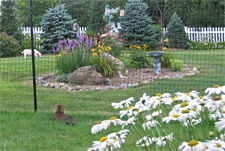 Fences are solution for Cayuga Heights deer issue Fences are solution for Cayuga Heights deer issue
I have attended meetings in the Village of Cayuga Heights for 1 1/2 years. I live nearby. I don't want the deer killed for any reason.
Cayuga Heights is viewed as an elite section of Ithaca for multiple socioeconomic reasons. Now, when people hear about it, they ask, "Are they the ones who want to kill the deer?" At a Cayuga Heights public meeting, a real estate agent expressed difficulty reconciling the fondness for and desirability of the village as a place to live with the trustees' apparent inability to resolve the deer issue without creating community divisiveness.
What is at the heart of this continuing controversy? Is it that someone would kill the deer to solve the deer/human conflict, before they would put up effective fencing to protect peoples' yards? Is it that outdated and outmoded fencing regulations are not being upgraded and modernized as the non-controversial solution?
Why is it better to shoot deer in a misconceived and costly long-term (if not endless) plan, rather than respectfully update fencing zoning that Cayuga Heights residents could use now?
I feel the village trustees are unfortunately straitjacketed by what they perceive or possibly project as public opinion. Fencing is a non-controversial solution that returns a peaceful harmony to Ithaca about this deer issue and allows everyone to move forward.
Charlene Temple
Ithaca
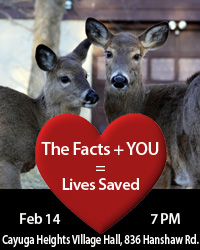 Former village empolyee and others take trustees to task Former village empolyee and others take trustees to task
Below are excerpts of public comments made at the 2/14/11 meeting of the Cayuga Heights trustees:
Michelle Poppensiek, former employee of Village Clerk’s office
(read by Mary Tabacchi):
“I am writing this as a 20-year resident of Cayuga Heights, and as a three-time former employee of the Village Clerk’s office, most recently from mid-September to late December of 2010. I was very concerned and upset to observe that after the December 6th public hearing on the DEIS [Draft Environmental Impact Statement], there was no apparent interest from the Mayor or Trustees in seeing the comments from the public, even though a vote was proposed for their January 10th meeting. The stack of letters from citizens sat in the office for weeks, during which time I never had a request to see any of them, which the Clerk herself did not even know were supposed to be reviewed by the Board. This attitude clearly showed me that the Plan is a done deal to these decision makers, regardless of intense criticism and public outcry, and that no further information or input was needed or desired.
“Beyond those grave concerns, I share concerns that have already been thoroughly detailed by others about the DEIS and the deer plan in general. The Trustees have the power and chance to still change their minds. It is not too late to reconsider, to take a step back, look at other options, and listen to the public dialogue. It takes real strength and courage to admit that one is wrong, or needs to rethink a decision, especially when considerable time, money and energy have been spent getting to this point.
“I ask you: Is it okay to kill in the name of making life easier for a small group of people? Is it right to kill a group of animals just because they are considered a nuisance to some people? Does it make sense to kill them even though this same action has been unsuccessful in other parts of the country? Do we want to teach our children that any choice, and any action, is better than inaction, even if it is harmful, barbaric, and highly controversial? Many of us think it is not okay to kill for these reasons. I urge you to take more time to consider alternatives and pay more attention to the people, who have made it clear that the DEIS is not acceptable to them, either as a scientific document, or as a moral option for controlling the deer population in the Village.”
Ann Druyan: “I understand that there hasn't been a decision, yet, about the Environmental Impact Report... I'm wondering if I can ask you when we'll know about that, and how we concerned citizens of Cayuga Heights, who really are horrified about the deer killing plan, can respond in a parliamentary fashion to your decisions.”
Pat Shea: “I would implore you, all of you, to change your stance on the proposed deer policy, that is, the particularly barbaric and reprehensible act of netting and bolting animals. How can you justify making a living thing suffer so much? Surely there is an alternative response to what is, in the final analysis, an inconvenience to some, and, at best, a nuisance to some others, but not to all the residents of Cayuga Heights. Please reconsider your stance and do not leave this legacy for the residents of Cayuga Heights.”
Angie Baker: “Where this deer slaughter plan is concerned, you have, up to this point, refused to hear, to be honest, to be reasonable, to be rational, to be kind, to be ethical, and to be wise. There's not anything inspiring or exemplary about this plan. If you go through with it, you will be choosing nothing more than the same types of acts committed by narrow-minded, self-serving bullies. The majority of people who responded to this plan are against it. The ridiculous rationales you have given for this slaughter have all been debunked by experts in their respective fields. Bullies are basically cowards acting on impulse, prejudice, inflexibility, pretension, and most importantly lacking that supposedly human-only characteristic of being able to put oneself in another's shoes. If you go through with this, the motivating force will be only the corruption of pride, arrogance and power. You'll be doing it because you can, and only because you can, as nothing else supports it. It's still not too late to change, though. I commend your consideration of the revision of the fencing ordinance. However.... I've heard you look to neighboring municipalities for various examples of how they do things. Ithaca has an 8-foot fencing ordinance to all property lines. Yet, when I drive through Ithaca, it's the density of humans I am forced to watch out for, not all the deer who are now congregating and starving in the road due to all of the 8-foot fences every one has put up to all of their property lines — another of the many absurd notions that's been put forth. There's not a deer problem in Cayuga Heights, and based on the underhandedness of your tactics, I know you all know it. The problem is with a small group of people who would rather kill than coexist. All you need to do is model your fencing ordinance on Ithaca's, and this will be over. It will take courage to shelve this plan after all these months. But you will be the better for stepping up and doing the right thing. There's always an alternative to violence.”
Meara (child): “Please don't kill the deer!”
Neil Golder: “I've been following this for a while, and I've been trying to understand why it's going the way it's going. I really can't figure it out. The only thing I can think of is... it seems to be about empathy and lack of empathy. Empathy for people and empathy for other beings -- empathy for the deer. I've served on Common Council, and I know that your jobs are very hard, and you have to pay attention to a lot of different people saying different things from different sides. And you have to act rationally. At the same time, I have to say that you have to act from the heart. Empathy means ‘feeling into’. It means feeling into what another being is experiencing or will experience. And I just hope you can do that.”
Lowell Garner: “When the Tucson massacres occurred... I cried for the fathers and families that lost their family members. It wasn't a Tucson problem, it's a problem with our society. Obama actually said, you have to expand the moral imagination, which I thought was a great way of stating, ‘wake up.’ I'm here because I know there are village residents, Village of Cayuga Heights residents, that feel exactly like I do... It's a terrible sight to see an animal suffer and the brutality that will occur... I have to start somewhere and take a stand and raise my voice so that I'm heard, so that I don't come in at the end of the story crying with other people viewing the massacre... my deer don't have tax maps. They live right across the village borders. My deer will move into this village when there's a vacancy. And I feel very strongly that they are sentient beings... We have destroyed the environment... and I'm not going to destroy life that already exists for something that has been extinguished by mankind.”
Charlene Temple: “I left a business meeting to be here on time, and these five Ithaca residents said, 'Haven't they figured that out yet in Cayuga Heights, about the deer? What's the solution going to be?' And I said to them, 'Well, I'm hoping the solution is fencing. Because there are clearly two different points of view.' I'm not going to ever be convinced that deer should be killed, nor will someone else be convinced that they shouldn't be killed. So that's not my goal. My goal is to try to find a solution where I feel good about saying to people, 'Yes, we figured something out where there was harmony in that option, where there was a solution, where there is empathy and sympathy for people who have different points of view.' I may be naive, but it seemed to me that fencing was a solution which would allow everyone to feel that some action was taken that most people were able to feel good about.”
Ann Serling: “Contrary to what the gentleman said that the majority of the residents in Cayuga Heights are for the culling plan, that has not been my experience in talking to people. They are vehemently opposed to it. Just for the record.”
Sherene Baugher: “I'm one of the professionals who wrote, and you have my letter, talking about all the flaws in the DEIS. I just hope that when your consulting firm makes the revisions to the FEIS that they address the substantial flaws that are there. But I also want to speak on the whole issue of fencing. Many upscale communities on the East Coast have allowed the residents to put in 8-foot fences. If you go to any of the sort of upscale tourist cities like Charleston, like Savannah, like Annapolis, they're not only just wooden fences, some of these 8-foot-tall fences are brick fences. And they are right at the property line. So, this whole idea that it will mar the upscale quality of Cayuga Heights, in terms of landscape architecture, just doesn't make sense. And as other people have said, fencing does allow an alternative to the deer problem, and allows each individual property owner to make those choices. So again, I hope that you don't have this resistance to a reasonable fencing plan.”
James LaVeck “You have presented not one shred of scientific evidence to support your claims that deer, and not human activities, are the greatest threat to the environment in this community. Yet how we can we take your purported concern for the environment seriously when FOIL [Freedom of Information Law] requests have shown that during the entire 30-month period you've wasted on this ill-advised killing plan, you haven't stopped – or even required modification of – a single development project in order to protect even one of the hundreds of species you list as being threatened by the deer. In fact, it appears that you have not even bothered to assess the presence of these species in even one location scheduled for development.
“And in terms of the environment, worse yet, you rescinded your public commitment to perform a headworks analysis on the 3 million gallons of natural gas drilling waste water this village processed into Cayuga Lake -- most likely because you already know that the carcinogenic heavy metals in that industrial waste passed right through your residential sewage treatment plant and went right into the lake, the source of drinking water for thousands. [Learn more: Let Them Drink Drill Water]
“The question hangs in the air tonight, why do you persist in pursuing this killing program to the point that your credibility is all but destroyed? Do one or more of you have an irrational need to take life, or to impose your will to the point of trauma on others? Do one or more of you somehow have a personal financial stake in carrying out this killing program? Is the deer issue a political wedge that you use to maintain control of the board, and thereby the ability to make decisions about the dumping of frack water into our lake -- especially now that the village has signed an agreement to accept waste water from undeveloped commercially zoned land in Lansing?
“This sort of speculation is the inevitable result of a governmental process that is rife with conflict of interest and lack of transparency. Because you have moved so much of the process behind closed doors, because you refuse to answer the most basic questions, because you refuse to listen -- even to national-level scientific experts -- you have lost our trust. Please reconsider the path you have taken. There is still time to choose a better one.”
Jenny Stein: “Overwhelming scientific evidence shows that killing deer in Cayuga Heights is not going to lower the risk of Lyme disease, yet you have over and over repeated this talking point at meetings and in the media, stoking irrational fears, particularly amongst the vulnerable residents of Kendal. Rather than wasting 30 months attempting to impose a violent and divisive killing plan on our community, imagine if you had instead followed the guidance of the Tompkins County Health department and instituted an education program focused on preventing and identifying tick bites. By doing that, you would have helped everyone in the community, harmed no one, and become a role model for other municipalities.
“In fact, during the 30 months that you have pushed this killing program, you have also failed, against all reason, to implement simple changes to the fencing ordinance that would easily and permanently address the concerns of frustrated gardeners without costing the taxpayers anything at all.
“While serious injuries from deer collisions are virtually unheard of in the history of Cayuga Heights, the potential for accidents is a concern to many, and therefore deserves attention. Roadside reflector technologies are being used all over the world and studies show them to be very effective. According to the traffic engineer of Owego, NY, the Strieter-Lite system reduced deer-vehicle collisions by nearly 100% in the areas it was installed. Local citizens have also frequently suggested at meetings that speed limits be lowered, speed bumps be installed, and that speed limits be more strictly enforced. Yet during the last 30 months, instead of implementing these practical and non-controversial ideas that would enhance the safety of everyone and harm nobody, you have focused your time and attention on figuring out how to convince this community that backyard mass slaughter of defenseless wildlife is necessary.
“You rejected nonviolent alternatives from the very start, claiming that they would take too long. Now that you have wasted 30 months and accomplished nothing, isn’t it time to rethink your strategy?”
Gabrielle Vehar: “I'm not going to rehash all the deer arguments as your minds seem pretty well made up. So I'm going to use my time to tell you my personal philosophy on how it applies, which is: All sentient beings are equal and deserving of respect and dignity. Now, while the deer are obviously included, the sentient beings I want to talk about are the human animals involved.
“First, all of those who responded in person. Because if they are in favor of the culling, most of them just want nice gardens, and they deserve the dignity that the right to put up a tall fence would afford them; and those opposed to the deer plan because we are human animals just as sensitive and sentient as everyone else, and thus deserving of the respect and dignity of being listened to and carefully considered.
“Secondly, the people who have expressed their views on the DEIS. They are deserving of respect and dignity because they care both about the nonhuman animals and the human animals who worry about getting Lyme disease, which we now know is a misapprehension, as it is not deer who spread it; and those who care about possible deer/vehicle interactions, which we can control by low speed limits, increased police control, and devices similar to Strieter-Lite reflectors.
“Third, for the sentient beings both near and far who have expressed their professional opinions of the DEIS and how it went against their sense of respect and dignity for all animals, both human and non-, by trying to perpetrate questionable science upon the village.
“Next, I would hope that those human sentient beings who would be traumatized forever by the violence being proposed would retain their right to respect by not being subjected to the killing.
“And finally, the mayor and trustees. I know that they, too, are deserving of respect and dignity regardless of whether or not we agree with them. For simply by being sentient beings, they are worthy and equal. And they will all have to live with whether or not they were able to show respect and dignity to all the worthy and sentient beings within their domain.”
Letter to Editor: "Deer-culling plan based on false assumptions"
 2/1/11: Cayuga Heights residents Dimitri & Irina Naydich write: 2/1/11: Cayuga Heights residents Dimitri & Irina Naydich write:
The Draft Environmental Impact Statement is a deeply misleading document that cannot justify deer-culling in Cayuga Heights.
Take, for example, the argument that deer-culling is an effective method of reducing Lyme disease. The major supporting reference in DEIS is "The Tick Management Handbook" by the Connecticut Agriculture Experiment Station. However, the handbook contains no data applicable to Cayuga Heights. All the actual studies cited in the handbook were conducted at ecologically isolated sites: three peninsulas, one island, and one coastal area surrounded by salt marshes. There is strong scientific evidence that deer culling on mainland does not reduce the tick population, as ticks survive on other hosts.
On a personal note, we have lived in Cayuga Heights for 10 years, and deer regularly come through our yard where we planted shrubs, trees and flowers. The deer used to eat them, but we have mostly fixed the problem by replanting and using net fencing.
DEIS de-emphasizes such humane and effective alternatives to deer culling. Fencing, roadside reflectors, nonlethal tick-reduction methods and public education will go a long way in solving the deer-related problems. The ongoing village fencing ordinance revision is a very encouraging step in the right direction.
 Letter to Editor: "Deer are just trying to survive" Letter to Editor: "Deer are just trying to survive"
12/24/10: Gayle Gray of Ithaca writes:
The deer in Cayuga Heights live within the context of nature's laws, taking no more food and water than necessary. Their attempts to endure on starvation rations, survive a broken leg or cross a busy road safely with their young are pitiful to witness. During hunting season, they are put on high alert, fearing for their lives while at the same time trying to survive the long cold winter.
I, on the other hand, enjoy food and luxury beyond my basic needs, live in a warm home and have the means to protect my family and myself. These advantages give me pause.
When I recently had a tick removed, the physician said to me: "We should get rid of the deer." One of the world's leading experts on the transmission ofLyme disease maintains that the deer's role in the spread of the disease has been greatly distorted, but even if I did become ill because of contact with a deer or any other animal, do I really have the right to eliminate that species because my well-being might be threatened?
In response to the claim that the deer in Cayuga Heights are overpopulated, there is no evidence that the number of deer has increased. It is stated that the deer population is presently between 170 and 210, which is in the same range indicated by a study done in 2000. Deer tend to regulate their numbers based on the available food supply and the harshness of the winters. It would be more accurate to say that humans are overpopulated, and that our greed and gluttony has driven many species to extinction.
Because we humans continue to expand our "territory," with absolutely no regard for the balance of the natural environment. The native habitat of Cayuga Heights was destroyed long ago when the houses were first built. The communities presently in place are not going to go away, so we must find a way to live in peace with the deer. Those who have concerns about their yards should advocate for the right to put up adequate fencing, not murder the deer who have been forced to eat our plants and leave feces in our yards.
The proposed "Net and Bolt" method of dealing with this issue is unconscionable, and I challenge anyone who supports this method to stand in witness as the procedure is executed, and then say that the experience does not torture his heart.
I am not naïve enough to think that we humans would be willing to give up our tyranny over nature. However, I fervently hope we will at least be able to identify with the innate desire in the heart of all creatures to survive as long as possible without pain, to raise their families with a modicum of peace and to live without constant fear and suffering.
Voices of conscience grow stronger
Below are excerpts of public comments made at the 12/13/10 meeting of the Cayuga Heights trustees:
So much death and sorrow is all around us because of forces largely beyond our control – natural disasters, accidents, disease. I can't comprehend that you're considering gratuitously adding to that toll. And adding to it in the most egregious and cruel manner... In my view you appear prejudiced and bent on killing. I urge you to reconsider this proposal. It's never too late to change one's mind. In fact, the ability to change one's mind is the mark of a truly confident and reasonable leadership.
I think when a governing body in a small community comes across an issue which is manifestly divisive and creates ill will in the community, they should back off and go to plan B.
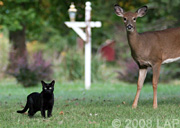 In 33 years of living in Cayuga Heights, I have never seen an aggressive deer. Never... To me, killing deer because we can is wrong. In 33 years of living in Cayuga Heights, I have never seen an aggressive deer. Never... To me, killing deer because we can is wrong.
I've lived in the village for 23 years, and have always thought of it as an extremely enlightened community. This is the first time I've ever been to a village meeting. I must say I'm quite astounded that the village board would refuse to allow people who want to fence off their gardens, and fence-protect their flowers and crops from deer, to do so, and prefer to take this route of killing deer with a method that, from everything I've read, sounds extremely uncertain and cruel... it seems to me you ought to give residents the choice rather than forcing us to be complicitous with this barbarous practice that you're proposing.
Years ago, I lived on a dirt road in Michigan. Walking the rural roads could have been an idyllic experience were it not for the deer entrails and deer heads commonly left by poachers. Deer season was, practically speaking, year round there. This depressing reminder of cruelty was commonplace. When I moved here in 2001, it was a joy to see these beautiful creatures in my back yard. I was glad to leave behind the haunting visceral images of mutilated deer. I was grateful that my new community wasn't as savage as rural Michigan. Now we prove ourselves to be exponentially more barbaric with the use of net and bolt slaughter... This inhumane and unethical plan will be a source of shame to Cayuga Heights and to Ithaca. Our community will suffer the repercussions of this abhorrent plan for years to come.
I can only say that the destruction, the shame on this -- not Cayuga Heights, the shame on me -- for letting this happen and standing by. I won't stand by and let this happen. These are too precious of beings to me.
I was in the YMCA when I heard three older women speaking about some flowers. What I heard next was, "Well it seems we're not allowed to put up fences." And then three heavy sighs. What I did not hear was, "Well it seems we're not allowed to use our shotguns to shoot the deer." Or, "Well, it seems we're not allowed to explode a net over the deer and then go take our bolt guns and kill them." They wanted fencing. Maybe you should talk to the rest of the community who aren't aware of your plans. You might learn something.
In a recent interview with WSTM, Mayor Supron made statements designed to continue to deflect the truth about how unnecessary, unfounded and extreme this plan to torture and kill the deer of Cayuga Heights is. She said, "There are people who say, well, the deer were here first." This objection is one of the least voiced. She went on to say, "But we live in a managed ecosystem, and therefore when it gets out of balance, we have to manage the ecosystem." What Mayor Supron and the trustees refuse to consider is that humans are also part of that ecosystem. Yet, responsibility for this so-called deer problem is being placed only on the deer.
 Your proposal calls for every deer in the village, except 20 or so who are sterilized and tagged, to be killed. Given you want the sterilized deer to serve as placeholders, they will be spread out across the village, and each will presumably be traveling with a herd of untagged deer. This means that along with the untagged deer, the tagged deer will ALSO be netted every single year that you perform net and bolt. So, in addition to the initial trauma of being captured and sterilized, they will now be trapped with the members of their herd and have to observe all of them being killed right in front of them... By the following year, they will have joined with other untagged deer who have migrated into the village where the plentiful and unfenced food supply has drawn them, only to have the same process repeated all over again. Knowingly subjecting an animal to this is, in my mind, sadistic, and demonstrates how out of touch the mayor and trustees are with the values of this community. Your proposal calls for every deer in the village, except 20 or so who are sterilized and tagged, to be killed. Given you want the sterilized deer to serve as placeholders, they will be spread out across the village, and each will presumably be traveling with a herd of untagged deer. This means that along with the untagged deer, the tagged deer will ALSO be netted every single year that you perform net and bolt. So, in addition to the initial trauma of being captured and sterilized, they will now be trapped with the members of their herd and have to observe all of them being killed right in front of them... By the following year, they will have joined with other untagged deer who have migrated into the village where the plentiful and unfenced food supply has drawn them, only to have the same process repeated all over again. Knowingly subjecting an animal to this is, in my mind, sadistic, and demonstrates how out of touch the mayor and trustees are with the values of this community.
I would like to direct my comments tonight to Trustee Liz Karns. According to the Cornell catalog, you are teaching a course called “Statistical Applications in Law and Policy: The practical aspects of quantitative research in law and policy... Students will evaluate the existing literature on a topic, analyze statistical merits, and make quantitative arguments. Standards of evidence will be considered...,” If you were to ask your students to evaluate the Draft Environment Impact Statement for the Deer Management Program using the principles taught in your course in order to give you their recommendation about whether or not you should vote to approve this document, what would their recommendation have been? If, as many of us believe, your own students would have given this report a grade of F, or at best a D... can you share with us your own reasons for voting to approve this document? Of all the trustees, you are the one most qualified to evaluate the quality of the evidence being presented in support of this plan, as well as the application of scientific principle and logic used to define the problem, evaluate possible solutions and their impacts, and fairly assess the pros and cons of various alternatives, including the negative impacts associated with each. As an elected official, we appeal to you to break your silence on this subject, and offer this community access to your considered opinion about the evidence, argument, and conclusions of this document, as well as an explanation for your voting to approve it. In doing so, you will be doing a service to people on all sides of this issue, not to mention providing a great example to your students of how to bring logic, rationality and integrity to a controversial public policy issue.
Read more recent comments, from the Dec. 6 public hearing, here.
Two powerful letters in this week's papers
12/10/10: In this week’s Ithaca Times, Anne Serling writes:
 I have attended several of the meetings regarding the deer in Cayuga I have attended several of the meetings regarding the deer in Cayuga
Heights. Each time I Ieave a little more disheartened. I can only describe
the initial proposal to bait and shoot deer in the village as sheer
insanity. I shudder to think of the consequences that such an act would
inflict on my neighbors and their children... Recently the board has come
forward with a new proposal — an egregious plan to “net and bolt” these
creatures. When I saw the video of this, I had to look away and wonder how
ANYONE could even stop for one moment to consider such an atrocious act.
Mayor Supron has said in a recent newspaper article that 75% of the village
supported killing the deer. She needs to tell us where that statistic came
from because I have talked to people in Cayuga Heights. Not one, I repeat
NOT ONE has ever been questioned as to their feelings about these proposals.
Those in favor of killing the deer have said that these creatures are
violent. For the past 25 years, I have run on Cayuga Heights Road almost
every morning. In those 30,000-plus miles I have, on several occasions, seen
deer and they have seen me. I have never had cause to be fearful. I have
never even been approached by these animals. To categorize them as
aggressive or violent is a misrepresentation. They are looking at the wrong
animal.
Anne’s complete letter can be found in the print version of the Ithaca Times, which is not yet online.
On Wednesday, an opinion piece written by Harold Brown appeared in the Ithaca Journal. Here is an excerpt:
This debate exemplifies not only a disconnect that demonstrates many-layered
hierarchies but a cultural story. The most obvious hierarchy is the human
dominance paradigm; another is the power hierarchy of the council over its
community. There is a deep psychology operating among those who see killing
of beings whose only indiscretion is being in the way of human wants. The
want for an otherwise artificial landscape, the want of control over that
which is considered invasive. In these things, we see a deep cultural story
borne out of 10,000 years of herding culture. A deep psychology that sees
nature as chaos and our role either as agriculturalist, wildlife managers or
consumers, as one of bringing order to chaos, bringing nature to heel; in
other words, humans living apart from the natural order.
As a former farmer and hunter, I understand the perception. In my opinion,
we must create a new story and find a better way of being in the world. As
long as we remain attached to the old story, we will continue to solve our
problems with violence. As psychologist Abraham Maslov said, "As long as the
only tool you have is a hammer, then all problems look like nails."
I trust that everyone — not only in Cayuga Heights but everywhere — would
agree that we yearn for a life of peace. And why not? All beings do. Our
difference from other species does not necessarily entitle us to domination.
If we prescribe to a belief in domination, then we shall always be at odds
with not only the natural world but with each other.
You can read Harold’s complete opinion piece here.
Public hearing highlights
Below are excerpts of public comments made at the 12/6/10 public hearing on Cayuga Heights' deer-killing plan:
Mahatma Gandhi said, "The more helpless the creature, the more entitled it is for protection by man from cruelty of man." That we are not willing to consider solving the problem through individual use of fences is unethical, uncivilized and representative of the style of governance that is becoming too pervasive, from Cayuga Heights to Washington.
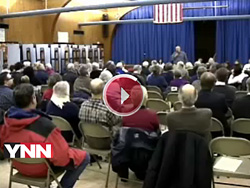 I do not want the children or elderly people in the village to be traumatized by killing or viewing of injured deer... I do not want to pay taxes for the slaughter of these animals... I believe that baiting and killing deer is unethical and cruel. I do not like being intimidated because I believe it is wrong to kill deer. It is unpleasant to live in an atmosphere of pressure and fear. I do not want the children or elderly people in the village to be traumatized by killing or viewing of injured deer... I do not want to pay taxes for the slaughter of these animals... I believe that baiting and killing deer is unethical and cruel. I do not like being intimidated because I believe it is wrong to kill deer. It is unpleasant to live in an atmosphere of pressure and fear.
Since this and the previous administration have continually called for deer remediation by lethal means, the village has become divisive, and it has destroyed the community spirit. We now have a split community... Why is the mayor and board of trustees more concerned about maintaining divisiveness within the village than creating a harmonious place to live?
I'm overwhelmed by the latest turn this farce has taken. Up until now, I have held back from talking about the inhumane aspects of former deer killing plans. I have focused instead on the dangers of firing guns in our small community. But this current plan is so ghastly, I have even refrained from telling my 13-year-old daughter about it because of the effect I know it would have on her. Net and bolt is a horrifying methodology, condemned the world round and illegal in our state. Why is mayor Supron so focused on this deer killing issue? ... I'd much prefer that our roads be fixed, that our school children be made more safe going to and from school, and that our water supply be brought up to modern standards, than waste any more time on these dangerous and shockingly inhumane plans made by a handful of people behind closed doors. A community is made up of intelligent people who care about one another. If we were brought together in a forum where we could really talk amongst ourselves in small groups instead of being given a few seconds to spot out position, we could hear each other and solve this problem. Put this issue into the hands of the community where it belongs.
The introduction and normalization of systematized mass slaughter -- I'm sorry, but it is technically slaughter, or killing, whatever you wish to call it -- is likely to produce a manifestly negative change in the character of any community. In this case, it also raises the question about a community structure of governance. It is well known that a portion of the community find the proposed plan both morally objectionable and extremely upsetting, but officials elected without anything resembling a mandate to kill are choosing to go forward in spite of visible and vocal opposition. This is a very significant change in the character of the community in terms of its culture of governance. A few short years ago, the mayor and the trustees did not implement a plan that had blatantly divisive effects and contravened the fundamental values of a significant proportion of the community. To blow off that portion of the residents both marks a failure of practical wisdom and threatens to make the community a house divided against itself. Besides the general effect of suspicion and mistrust, for many there is disillusionment in the sense that there is no real democratic exchange, respect for the views of others, and a willingness to compromise on issues that for some are very basic... The lack of hard data and clear outcomes in this plan, its seemingly inevitable failure, it's bound to go on and on and be not sustainable, but have to be repeated annually, as well as its exorbitant coast, cannot diminish suspicion or create good will. This is especially the case when there are obvious less costly and viable alternatives to the plan, one of them being flexibility with respect to the fencing policy.
Ten years ago, I served on the Cayuga Heights deer committee, which consisted of people who wanted deer reduction. We met for two years, every other week... a survey was sent to every one of the approximately 800 landowners, and the response was high. While, like now, the majority of residents wanted deer reduction, only a third or less were willing to kill deer. No such survey has been done since then to determine whether the community as a whole now favors killing. Without this information, it is difficult to know that we are properly represented by the proposed deer management policy. It appears, or might appear, that we're being bullied and taxed to serve the needs of a minority view. 2006 was the last time the deer population was studied, and the number was determined to be 147. This number is close to what was found by Cornell 10 years ago, and indicates that the herd has not actually grown. However, the issue on the table has not really been the number of deer. The issue is whether a minority of residents who perceive deer to be an intolerable problem can determine the policy and budget that serves their interest but not necessarily that of the whole community.
 We're involved in so many endless wars in this country. Many people think the way to solve problems is to pick up a gun instead of using their brains and negotiating and figuring out other ways to solve problems. This seemingly ever larger group gets more powerful every day. So we find ourselves with a local government not unlike the federal one deciding to kill as THE way to get things done. I have attended several meetings on this subject at the town hall, and have never heard the board discuss alternatives to killing. They seem to be obsessed by using guns to solve this problem. It surprises me that the most privileged group of people in this area could be planning to kill local wildlife in an illegal and most painful way. Where are the educated and those who care for wild things in the village? What has happened to the knowledge that fences keep out unwanted animals from yards and gardens? Are fences too much work? Too ugly? Too insulting to our neighbors? The bottom line is that they work, and in my experience, send animals elsewhere looking for food. We're involved in so many endless wars in this country. Many people think the way to solve problems is to pick up a gun instead of using their brains and negotiating and figuring out other ways to solve problems. This seemingly ever larger group gets more powerful every day. So we find ourselves with a local government not unlike the federal one deciding to kill as THE way to get things done. I have attended several meetings on this subject at the town hall, and have never heard the board discuss alternatives to killing. They seem to be obsessed by using guns to solve this problem. It surprises me that the most privileged group of people in this area could be planning to kill local wildlife in an illegal and most painful way. Where are the educated and those who care for wild things in the village? What has happened to the knowledge that fences keep out unwanted animals from yards and gardens? Are fences too much work? Too ugly? Too insulting to our neighbors? The bottom line is that they work, and in my experience, send animals elsewhere looking for food.
I've heard the term stewardship of the earth and environmental concern voiced by people ready to cull the deer herd. The stewardship of the earth, which man has been responsible for, had been dismal, and we are all feeling the consequences... As far as damage to property is concerned, I am a neighbor of a lot of these people, and I have no idea what they're talking about. I'm a very keen gardener. I have an acre of garden and no fences. I go to Agway, I find out what deer don't like. And okay they eat the odd things I don't expect them to eat. On the other hand, I grow a lot of things that deer will not eat. And it's perfectly possible to be a food gardener here and share you garden with the deer.
I'm wondering, because I've been to a number of meetings, what is going to factually resolve all our differences? As someone said, of course we all have differences of opinion, and I'm wondering if supposition has taken the place of facts... people have very vivid anecdotes that support their point of view, and I don't know if they are the minority or the majority of the village residents. But I would really like to see a non-killing resolution come to pass... where I came from, from Boston when I moved here in 1970, I never saw one deer. And I consider it part of the culture of Ithaca that, besides the culture we get from the universities and people living here, we get wildlife and beautiful geography, and I'm grateful for that.
Whether the decision is for bait and shoot or net and bolt, it will affect the environment in a way that a couple more feet of fencing for a garden could never do... Do we want our children to grow up seeing the world as a completely hostile environment where a rifle or an explosive net and bolt gun may go off at any time? Or where a dead and bloody carcass may be viewed out the window?
For the past two years, I have watched silently and with progressively more outrage at each deliberation of the Deer Remediation Advisory Committee and the Cayuga Heights board. But now because of the disclosure of the latest proposal and intent, netting and bolting, presented in the Environmental Impact Statement, I am compelled to speak out... there is mainstream neuropharmacology supporting the assertion that fear and stress, and not pain, are the most inhumane of all stimuli we can inflict upon an animal. Even those who earn their living by eliminating deer speak out about the increased stress the animals experience with the net and bolt technique. Netted deer will agonize from the most severe form of fear. I can't emphasize this enough. From the time the deer are netted until they are killed, these animals will suffer.
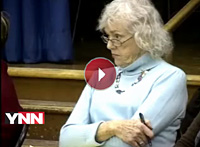 In the DEIS, it said that deer feces are deposited daily in the local watershed, essentially, implications made killing all these deer is going to save our water from pollution. But I'd like to ask everyone here how many people in our network of friends and family have suffered from cancer? What causes cancer? Have you ever heard of hexavalent chromium? Hexavalent chromium was found in the 3 million gallons of water that Cayuga Heights took money to process through their sewage treatment plant, which was never designed to process industrial waste, into Cayuga Lake. When environmental attorney, Helen Slottje, came and brought this to the attention of the trustees, they did not follow up. A Freedom of Information Request showed that they did not investigate what she said, and after she spoke, they later rescinded a headworks analysis that they had scheduled that would have shown that the water that went through the sewerage treatment plant did not have the heavy metals removed. So, I ask you, are heavy metals deposited in the source of the drinking water for thousands of people, is that less important, is that not due any public discussion? Instead we're going to have a protracted debate on the horrors of deer feces. In the DEIS, it said that deer feces are deposited daily in the local watershed, essentially, implications made killing all these deer is going to save our water from pollution. But I'd like to ask everyone here how many people in our network of friends and family have suffered from cancer? What causes cancer? Have you ever heard of hexavalent chromium? Hexavalent chromium was found in the 3 million gallons of water that Cayuga Heights took money to process through their sewage treatment plant, which was never designed to process industrial waste, into Cayuga Lake. When environmental attorney, Helen Slottje, came and brought this to the attention of the trustees, they did not follow up. A Freedom of Information Request showed that they did not investigate what she said, and after she spoke, they later rescinded a headworks analysis that they had scheduled that would have shown that the water that went through the sewerage treatment plant did not have the heavy metals removed. So, I ask you, are heavy metals deposited in the source of the drinking water for thousands of people, is that less important, is that not due any public discussion? Instead we're going to have a protracted debate on the horrors of deer feces.
There's been repeated mention of a concern for biodiversity with great attention paid to songbirds and wild flowers. However, biodiversity is a concept that encompasses much more than a handful of species. It addresses all species in an ecosystem – animal, plant, those that can sing, and those that cannot. I have previously brought to the attention of the trustees research that shows reducing deer can lead to a reduction in reptiles, amphibians, invertebrates, members crucial to the health of any ecosystem. Yet, the DEIS shows that no consideration has been given to these species. Even if for the moment, we just consider birds. Research has shown that reducing deer can lead to the reduction in ground nesting birds. Other research has shown significant decreases in bark foraging birds such as woodpeckers. Yet another study has shown decreases in species such as blue jays, northern cardinal and Carolina wren. The point is, as one researcher concluded, management actions taken to regulate deer densities could have the unintended effect of reducing local animal diversity. It's also revealing that requests under the Freedom of Information Law for documentation of consideration of biodiversity and the approval of development projects had returned zero results to date. Therefore if biodiversity is indeed a sincere concern for the trustees, I call on them to perform the necessary field studies to measure and quantify biodiversity in the village before proceeding with this environmentally impacting plan.
In the research I've done on the situation, I fail to see really good robust science. I feel like there's a lot of biological questions that have not been answered. What is the deer population? What is the biodiversity numbers of different species? How will eliminating deer affect that? What about the corridors that the deer should be using going in and out of Cayuga Heights? If they are starving, why aren't they moving on? Those are really important questions. If those are not addressed before any action is taken, the whole deer population might come up again in another 5, 10 years
Five Cornell Law professors speak out, plus two letters in the Ithaca Times
7/16/10: In the last week, there have been two letters to the editor and one opinion piece published in favor of a non-violent alternative to resolving the deer conflict in Cayuga Heights.
 The opinion piece, published in the Ithaca Journal, was based on a letter that was presented to the Cayuga Heights trustees at their last meeting, on behalf of five professors at the Cornell Law School: Prof. Sherry Colb, Prof. Michael Dorf, Prof. Robert Hockett, Prof. Steven Shiffrin, and Prof. Laura Underkuffler. The letter detailed their opposition to the proposed bait-and-shoot program, based on its inherent cruelty to animals; the distress it will cause many people in the community who care about these animals and know many of them as individuals; the danger posed to innocent bystanders, human and non-human, both in and around Cayuga Heights; and the divisiveness and rancor that will only grow worse in our community should an annual killing program of this nature be implemented. The law professors pledged their moral support in the event of a legal challenge. Read the complete opinion piece here. The opinion piece, published in the Ithaca Journal, was based on a letter that was presented to the Cayuga Heights trustees at their last meeting, on behalf of five professors at the Cornell Law School: Prof. Sherry Colb, Prof. Michael Dorf, Prof. Robert Hockett, Prof. Steven Shiffrin, and Prof. Laura Underkuffler. The letter detailed their opposition to the proposed bait-and-shoot program, based on its inherent cruelty to animals; the distress it will cause many people in the community who care about these animals and know many of them as individuals; the danger posed to innocent bystanders, human and non-human, both in and around Cayuga Heights; and the divisiveness and rancor that will only grow worse in our community should an annual killing program of this nature be implemented. The law professors pledged their moral support in the event of a legal challenge. Read the complete opinion piece here.
In addition to the law professors, two more citizens added their voices to the debate. In this week’s Ithaca Times, Zaira S. Chaudhry wrote:
 “I, for one, cannot fathom how a committee comprised of notable, intelligent individuals could arrive at such an undeniably inhumane ‘solution.’ Perhaps to some this ‘solution’ seems to be the easiest to implement, however the easiest solution is not always the best solution. It would, indeed, be easy to implement a deer-killing program but wouldn't it be best to do what is right? The proposed deer killing program falls nothing short of genocide, and the proponents of such a program show absolute disregard for the value and preservation of life.” “I, for one, cannot fathom how a committee comprised of notable, intelligent individuals could arrive at such an undeniably inhumane ‘solution.’ Perhaps to some this ‘solution’ seems to be the easiest to implement, however the easiest solution is not always the best solution. It would, indeed, be easy to implement a deer-killing program but wouldn't it be best to do what is right? The proposed deer killing program falls nothing short of genocide, and the proponents of such a program show absolute disregard for the value and preservation of life.”
Zaira ends her letter by quoting Mark Twain, who said, “The fact that man knows right from wrong proves his intellectual superiority to the other creatures; but the fact that he can do wrong proves his moral inferiority to any creatures that cannot.” You can read her complete letter here.
And finally, our friend the dancing deer put pen to paper and, as a resident of Cayuga Heights, challenged the mayor and trustees to a public debate on the deer issue. His letter appeared in last week’s Ithaca Times, and while it’s not available online, here’s an excerpt:
“Having asked the Mayor and/or any Board members to publicly debate me on three separate occasions (twice in person at Board meetings and once in writing) which would be open to the community, cordial, and covered by local press, their response has been to ignore me every time. I can only figure they don’t want to be embarrassed by how ridiculously easily their reasons for Bait and Kill collapse into garbage when faced with some basic questions... I can already hear some of their excuses, We’ve already talked about the issue enough, we’ve explained the reasons, how long must we discuss this, etc. Oh, they’ve talked plenty, all right, but they haven’t answered most of the questions about their talk, and that’s unacceptable... In a week I’ll be moving downtown, and the Board will label me an ‘outsider’... So I once again ask Mayor Supron or any member of the Cayuga Heights Village Board to let me question them — and vice-versa if desired — in a polite, civil, public forum, before I’m an ‘outsider’ who is ignored entirely and given no say in matters pertaining to my community. Wait... ignored and given no say in matters pertaining to my community... well, hey, it’ll be just the same as when I was a Cayuga Heights resident!”
2/3/10
Letter: Supron prefers to kill deer than be flexible about fencing
In the Ithaca Times, Douglas Louer takes Cayuga Heights officials to task, writing:
According to the December 2009 issue of the Cayuga Heights Courier... Mayor Jim Gilmore and Deputy Mayor Dave Donner will be stepping down and not running for reelection in March. For those frustrated by, among other things, Gilmore and Donner's lack of interest in citizen input regarding alternatives to the danger and violence of their deer killing plan, this is good news.
The bad news is that it looks like Kate Supron, who was chair of the deer killing committee that advised implementing this plan in the first place, and who was appointed rather than elected to her trustee seat, is planning to run for mayor. She is an unconditionally ardent proponent of bringing gunmen into the village to shoot deer at undisclosed times, in undisclosed locations, and for an indefinite period of years.
Not only will this deer killing plan negatively impact the safety of the village, it will also negatively affect property values, the ability of villagers to sell their homes expeditiously, and the former peaceful cohesion of the village, divisive as this deer killing plan has already proven to be, pitting neighbor against neighbor. And that's not even mentioning the horror this will bring to the deer who have done nothing wrong except be deer and do what deer do. They are gentle, graceful, affectionate beings who form associations with each other as well as with us. They don't deserve to be gunned down in cold blood because three dozen or so Cayuga Heights residents don't like them.
The so-called "public" hearing on the deer plan that the Cayuga Heights trustees, who are unanimously in favor of killing the deer, held was manipulated in favor of deer killing. The wife of trustee David Donner as well as trustee Bea Szekely took names as people arrived, also asking if you lived in Cayuga Heights or not. Those giving public comments were then hand-picked, regardless of their order of arrival or place of residence, to speak. Thus, many who were in favor of alternatives to killing the deer, and who had arrived early, had to leave for various reasons before they were called on to speak, some because they were there with their children... There were also no-parking signs along all the side streets surrounding the Cayuga Heights Elementary School where the deer "public" hearing was held, thus shutting out many. Yet, when the school holds events for its own student body, there are not any no-parking signs along the side streets. Interestingly, during the course of the deer "public" hearing, the no-parking signs were removed.
Kate Supron, who consistently uses such pseudo-euphemistic terms as "remediation" and "culling" when referring to killing the deer, has already dismissed each and every alternative and opinion outside her own, and will utilize anything, however factually inaccurate, glossed over, distorted, exaggerated or special interest, to try and rationalize her plan... She wants the deer dead, she wants to bring in snipers to kill them (in violation of the village's own gun ordinance), and she has stated that maintenance (continued killing) will be necessary for an indefinite number of years. She's myopic about the fact that what she proposes will have no effect whatsoever. Unless she intends to turn Cayuga Heights into a gated community, for every deer she kills or subjects to sterilization surgery, another will come in. Once in office, regardless of the sound bites she may use to filter it otherwise while running, she will actively pursue this close-minded, one-track, ineffective course, and will use whatever behind-closed-doors methods she can get away with to make it happen. Remember, she was put into her present trustee position as an appointee rather than as someone elected by the constituency she is supposed to represent, another indication of her ethics.
She, as well as the other current trustees, also intend to more strictly enforce the fencing ordinance in Cayuga Heights, with corresponding harsher penalties for being out of compliance. Supron, the other trustees, and their three dozen or so supporters, would rather shoot the deer than be flexible about fencing.
March for Compassion
6/11/10: About 20 people of all ages carried signs and banners while our friend, the dancing deer, entertained the crowd with his humorous antics. Thousands of people showed up to watch the procession. We were thrilled to see many in the crowd cheering as we walked by, giving the thumbs up and eagerly accepting the informational pamphlets we were handing out -- proof that there is plenty of support in our community for an alternative to killing deer in Cayuga Heights.

 Letter to Editor: "Deer culling arrogant" Letter to Editor: "Deer culling arrogant"
1/22/10:
In today's Ithaca Journal, Elizabeth Root of Trumansburg writes:
So the Village of Cayuga Heights has decided to slaughter offmost of its deer residents? Even though experts document the effectiveness of contraception? This is too expensive for the affluent citizens of Ithaca's wealthiest neighborhood?
The negative effect of deer on biodiversity is negligible compared with the human effect. Yet Homo sapiens is in no hurry to ameliorate the catastrophic consequences of its massive overpopulation and contribution to Earth's direst threat, global warming.
In its usual audacity, our species has declared domination over all other forms of life on Earth without blinking an eye. Now just who is going to decide when it's time to cull the human population? Let us think about this and rethink our place in Earth's ecosystem. Let us please be better stewards of Earth and of our fellow blameless species.
1/13/10
Former Cayuga Heights deer committee member says Ithaca Journal article misleading
 Clarifying the deer problem Clarifying the deer problem
The front-page Saturday article about deer was generally well-written - except that one of its headlines is misleading, since the experts in the article do not say specifically that the Heights deer are a threat to biodiversity.
As far one can tell from the article, the experts' only reference deer in general. The point is made that the understory is affected by deer. But this does not apply to the Heights situation or residential areas in general because the understory is well-groomed by landowners, not deer. It is only in the forests that the understory is affected by overpopulation. It is up to the annual hunting season to reduce deer numbers that affect this wilder terrain.
The other misleading point is the statement that deer are the biggest threat to biodiversity. The biggest threat can be easily seen by looking in the mirror.
I served on the original "deer committee" that determined through extensive village meetings and two highly responsive residential censuses that the majority of residents chose the sterilization method of control. No such census has been conducted by the current administration.
Jeff Cox
Cayuga Heights
 11/14/09 11/14/09
More people speaking out
There have been some helpful letters published in the Ithaca Journal recently from people opposing Cayuga Heights’ deer-killing program:
Middle school teacher concerned about message Cayuga Heights is sending to children
Excerpt:
I am deeply worried about a culture that justifies eradication of deer by referring to them as "vermin" and "pests," or a threat to gardens and the aesthetics of the community (inasmuch as fencing is a remedy). This instrumental and cruel language is repeatedly used to justify "culling." Language matters - especially where children are concerned - and this language signals that something is deeply wrong.
Ithaca includes Cayuga Heights, despite the repeated reference to guest speakers as "outsiders" at the preliminary hearing on deer culling. This community is committed to non-violent and imaginative solutions, not the violent actions and language of the Wild West. If Cayuga Heights is to become a gated community, sterilized of wild life that was, after all, here first, then we all might as well be living in a soulless suburb, where wilderness and its challenges are wiped out forever. This action is a brutal harbinger, and I suspect it will eventually receive the widespread outrage that it deserves. I would consider it a duty to raise awareness of this action among children - to situate it in language that is, at least, honest.
Finally, I have witnessed this sort of "culling" in suburban areas of Canada and it was indeed the beginning of the end for communities that had achieved a kind of equilibrium with wilderness. These actions bespeak an inhumanity and lack of imagination that is appalling.
--Brad Zukovic, Ithaca
Cayuga Heights resident points to lack of evidence to support deer-killing plan
Some villagers, willing to have animals killed for the sake of plants, have recounted fantasy-laden anecdotes that transform deer into threatening beasts or infectious vermin. Yet no one at the recent meeting provided an instance of actual aggression by deer. What's more, ticks causing Lyme disease come from many sources, including mice.
Anecdotes are no substitute for a convincing study of the problem, which the trustees have not furnished. And undisclosed killing fields would create obvious dangers, arguably greater than that of deer crossing residential roads with low speed limits.
Could it be that the idea of killing most deer, and leaving others as a kind of sterilized zoo, attests to an egocentrism in terms of which everything exists for the sake of "us" humans who may do almost anything we like with members of other species?
--Dominick LaCapra, Cayuga Heights
Cayuga Heights resident critical of process and purpose behind deer-killing plan
My first letter to the editor of the Journal in 30 years of living here is about the Village of Cayuga Heights hiring snipers to shoot deer so that residents of this affluent community don't have to buy fences to protect their tulips.
While it might be hard to imagine a more far-fetched plot line for a fiction novel, one needs only to add that the village board of trustees unanimously favors the shootings and has attempted to ban public comment on the plan at its meetings. And all for the bargain price of slightly more than a million dollars in tax increases over the next 10 years. If this is what the village will do to deer for eating tulips, what is in store for those drivers who consistently speed on Triphammer Road?
--Thom deLara, Cayuga Heights
Local therapist says Cayuga Heights deer debate has become "nutty"
I have gone to public meetings and heard Cayuga Heights residents speak of deer as predators, and as disease-bearing, violent animals. There were eight deer/car collisions in 2008. I feel like this debate has, frankly, become nutty. People have become angry and paranoid about deer, and about people who do not wish to have deer eradicated.
We also have other animals causing destruction to yards and gardens: rabbits, squirrels, dogs, ground hogs, beavers and woodpeckers. They leave scat everywhere, too. Should we kill them also? I feel that living with animals is part of the beauty of Ithaca: of having city and country living with a rich cultural atmosphere. We are famous as a tourist attraction for our waterfalls, Finger Lakes Trails and Cayuga Lake. There are calendars and postcards that in their pictures show this and also deer grazing. Are we really trying to create an environment which annihilates deer and decimates part of our natural beauty?
Honestly, it all feels morally shameful to me.
--Charlene Temple, MSW, LSCW, Ithaca
Click here for more information about where you can send your letter to the editor.
10/23/09
Dozens of protesters and dancing deer make TV news. Trustees unmoved.
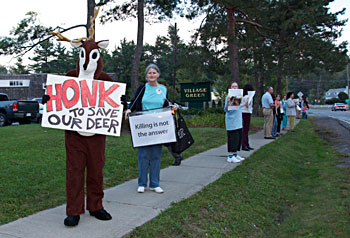 9/26/09: Monday's protest drew more than 25 participants, including a dancing deer! Both the Ithaca Journal and Channel 10 News covered the lively event. Sadly, despite the great turnout, the many passionate public comments, and the growing media coverage, the mayor and trustees showed no sign of interest in what the overwhelming majority of meeting attendees were trying to communicate. 9/26/09: Monday's protest drew more than 25 participants, including a dancing deer! Both the Ithaca Journal and Channel 10 News covered the lively event. Sadly, despite the great turnout, the many passionate public comments, and the growing media coverage, the mayor and trustees showed no sign of interest in what the overwhelming majority of meeting attendees were trying to communicate.
Instead of listening to their constituents, and many other Ithaca residents who are outraged by their deer-killing plan, the trustees chose to take matters in a more drastic direction, reducing the numbers of deer who may be allowed to live to as low as 20 (instead of 60, as the original plan recommended), and counting the sterilized deer from a previous program in that number so they can get to the killing as soon as possible. So Cayuga Heights' "deer remediation" program is looking more and more like a deer extermination program, with the mayor and trustees hoping to annihilate all but these 20 or so deer in one year, which could happen as soon as this winter if they are not stopped.
People protest, deer comment ban reversed, "draft" kill program approved
8/27/09: More than 20 people peacefully protested outside Marcham Hall, as the trustees arrived for their monthly meeting, along with members of the public who were attending.
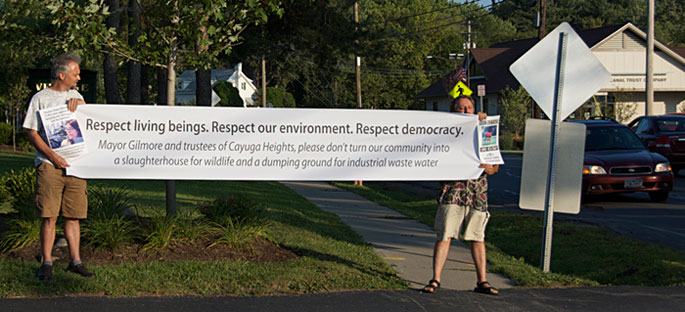
When the meeting began, protesters brought their signs inside and stood witness to the proceedings. The trustees acquiesced to the protesters, reversing their ban on public comments about the deer issue under the condition that Cayuga Heights residents were given priority, and that comments would go on for no longer than a total of 30 minutes. Many eloquent statements followed from people who are opposed to the killing, who again greatly outnumbered those speaking out in favor of it.
At the February 17, 2009, Board of Trustees meeting in Cayuga Heights, 9 citizens spoke out against a bait and shoot program. Here are some of their statements that were read and submitted for the record:
Scott Teel: The deer are not purposely targeting your plants and you. They need food, they find food, they eat what they find. Your plants are just plants to them, not YOUR plants. Don't be angry with a creature that eats food you put out. It's like sending you or I to a buffet, handing us a plate, and saying, "go ahead," and then getting angry with us for eating. The deer aren't being malicious, they don't hate you; they're hungry. Understand this and you won't hate them either. There are better, less violent ways to deal with them...
I myself walk my dog late at night, sometimes in the middle of the night, to clear my head or get out to walk off a problem. What if a sharpshooter accidentally shoots me? Can you guarantee 100% that no dog or person will ever be harmed by one of these shooters? 100%? If not, your choice should be easy...
What are the local gun ordinances for this neighborhood? I'm not willing to change them to eliminate a few deer, personally. Is it sporting to put food down for an animal and then kill it? What happened to Ithaca's famous open-minded, welcoming, fair and even-handed attitude? ...
I love this community, it's a wonderful place to live. The deer are PART of MY community. I love the deer. I love to see them wander around, I love to see the fawns playing in the spring, running around like puppies. I think they're great. They're a wonderful part of this area. I rent a house now, but will be buying eventually. If this bait and kill program is approved, I won't be able to buy a home here in Cayuga Heights. It will be too much of a turnoff, too horrible of a thing for me to live near. I'll look elsewhere, perhaps not in Ithaca at all. That's how strongly I feel against this. I would move from an area where the residents felt this program was necessary. I don't want my taxes to go toward something like this when I know there are alternatives. I'm one of the most open-minded people you can meet, I always teeter back and forth toward both sides of any arguments that have good merits. I've seen the arguments pro and con for this deer-killing program and am not teetering at all on this one.
So I ask my friends on the Board to vote against this program. The deer are a part of nature, and we often forget that we are as well. Nature does what it does. Nature can be a nuisance. Sometimes nature causes problems. But just because something is a problem doesn't mean we should start killing it... just because we can and it's easy. That will create new problems. Let's deal with this issue in a more compassionate way, which we -- as humans -- are capable of doing as well.
Read complete written statement
Jane Staller: (statement read by Eric Huang) I am a long-time resident of Ithaca, N.Y. I am concerned about the proposed bait-and-shoot culling of deer in Cayuga Heights, which is a part of the Ithaca community and a place where I spend a good part of my life, for my job, social life, as well as for shopping and just traveling through.
It seems to me that residents of Cayuga Heights and those who travel through and spend time in Cayuga Heights should be informed when deadly weapons are going to be used in the neighborhoods where they reside or spend time. I certainly feel it is my right to know this.
I also have concerns about the efficacy of the culling process, which I understand involves some 10 years of these "secret shootings". This does not sit well with me, and I imagine there are many people, both residents and others who don't reside within the boundaries of Cayuga Heights, who agree with me.
Nancy Jacoby: I am a resident of Ithaca. I spend frequent time in Cayuga Heights visiting friends and volunteering with senior citizens. I find that my visits to the Heights are peaceful and enjoyable, owing to its natural beauty, its friendliness for pedestrians, and the abundance of creatures living side by side with human beings.
I'm opposed to a bait and shoot of the deer in this area. Even if carried out under the cover of darkness, this violent activity will be painful for the animals who are shot, those who will be injured, and those who will watch their young, and the other members of their herd, fall and bleed and die.
 Finding peace in this world will begin not through grand orchestrations, but through the conglomeration of many small acts of kindness, empathy and compassion, and a willingness to commit ourselves to non-violent resolutions to all conflicts. The simplest of these are our dealings with animals, who represent no political ideology, but merely a desire to coexist in the environment to which we are all equally entitled, humans and animals alike. I encourage the trustees to choose from non-lethal solutions to manage deer in Cayuga Heights. Finding peace in this world will begin not through grand orchestrations, but through the conglomeration of many small acts of kindness, empathy and compassion, and a willingness to commit ourselves to non-violent resolutions to all conflicts. The simplest of these are our dealings with animals, who represent no political ideology, but merely a desire to coexist in the environment to which we are all equally entitled, humans and animals alike. I encourage the trustees to choose from non-lethal solutions to manage deer in Cayuga Heights.
Sherene Baugher: I've been to a number of the deer meetings, and I just want to say that there's been a lot of misinformation, or misleading information, or outright factually incorrect information presented by the deer committee. For example -- and it was in the press, too -- statements by the mayor and by the committee that we have a noticeable decrease in birds within the village because of the deer. When I checked with Cornell, when I checked with Audubon, there's no statistics that back up the mayor's statements.
The mayor has also stated in the press about the increasing dramatic rise in lyme disease, and that this is a great threat, why we need to cull and kill the deer. Checking with the health department, there is an increase all over the state in the numbers of lyme disease because the state has new methods for reporting. And they said it's misleading to use these new statistics as scare tactics with the public.
Jenny Stein: I was born in Ithaca, so like the deer, I am native to this area. I care about what happens in my community, even though an invisible border separates the residents who live in Cayuga Heights from the rest of us who consider Ithaca our home. I have attended all but one of the publicly held deer committee meetings, and there are many questions yet to be answered. Here are just a few:
- How is it determined that there are currently too many deer in the village, when the last count was conducted three years ago?
- If a deer killing program is implemented, how will its success be measured, especially if you don't know how many deer you started with, making it impossible to prove the population was reduced?
- There's an assumption that killing deer on one end of the village will help resolve people's conflicts with deer on the other end of the village. Why has there been no serious consideration given to solving the actual conflicts people are having? After all, isn't it the conflicts that give people the perception there are too many deer?
- I have seen no serious consideration given to compensatory rebound effect, a scientifically documented phenomenon where deer have more twins and reproduce at a younger age when there is a sudden drop in their population. How will it be determined that the killing is actually reducing the population size, and not merely stimulating higher reproduction rates, leading to even more dee r the following year? r the following year?
Read the complete list of unanswered questions
I am concerned that an annual bait and shoot deer killing program in Cayuga Heights will do permanent damage to the non-violent culture of the Ithaca community I so love, as well as put many people and their companion animals at risk -- and not just those who voted for you. A lot of us who didn't will have to endure the negative consequences of your decisions.
At the January 26, 2009, Board of Trustees meeting in Cayuga Heights, 14 citizens spoke out about the deer issue, 12 of whom expressed their opposition to a bait and shoot program. Here are some of their statements that were read and submitted for the record:
Gabrielle Vehar: I would like to tell the story of the bait and shoot approach as it has transpired in Amherst, NY, where I was raised and lived during the height of the bait and shoot controversy -- a controversy that lives on even to this day. Yes, Amherst is still struggling to come to a resolution as it looks back on more than ten years of mistakes. Some of these mistakes include taxpayer-funded studies that cost at least $100,000 and whose recommendations of non-lethal methods were then ignored. Another is the terrible fighting that the bait and shoot controversy caused between local legislators and townspeople, fighting that still goes on to this day.
Additionally, there were promises made by the Amherst Town Board to make efforts toward non-lethal solutions, only to have these promises reneged on, causing members of the Deer Management Committee to actually resign in disgust, as Amherst turned back once more to bait and shoot. Yet another is the grave danger of never knowing when or where the next bullet from a sharpshooter's gun might strike, as it did once already, just over the heads of an East Amherst father and son sitting in their home.
And finally, the sheer futility of a town government bent on using bait and shoot, only to see its deer-vehicle collision numbers rise again, a full five years after initiating the program. All this, while well-tested and utilized non-lethal methods that are nationally recommended sit gathering dust in the corner.
I will be submitting a more in-depth report detailing the story of Amherst bait and shoot, referenced with foot notes, but I would like to leave you with this thought: Five years after the bait and shoot program was initiated, with more than one thousand deer killed, years of meetings, vast sums of money spent, and a near brush with a tragic accident, the town government of Amherst still has a bitterly divided community, still has failed to develop a successful strategy for reducing deer-vehicle collisions, and still has failed to implement cost-effective non-lethal methods with a proven track record of success.
Will we sit idly by while the Cayuga Heights' trustees make the same mistakes? I sincerely hope not. Read the report about Amherst
Mary Tabacchi: Many of us pay taxes here to live in a quiet, safe, friendly environment. I want to impress upon the trustees once more that baiting and culling is an extremely cruel concept for a community to condone. A number of us feel this approach is barbaric... Brutally killing a group of deer while they are feeding suggests we have lost our way as peace loving, responsible guardians of our community.
I have several pictures here taken after a deer culling near Rochester Hills Michigan... I would like my assembled colleagues to look at these pictures if they can. These pictures do not show dead animals but they show where the deer were baited with corn. They show blood on a tree from the deer and they show a bloody trail of a deer trying to escape. Deer do not necessarily die instantly as can be shown by these pictures. Believe me - these pictures are mild compared to the carnage that will occur in our own community. Read complete written statement
|
|
| Photos of the aftermath of a bait-and-shoot deer killing operation in Rochester Hills, Michigan. Photos were taken January 21, 2009. by Italia Millan. (click an image to enlarge it) |
Karen Kaufmann: I have lived in the Village since 1990... I urge the Board to give the issue of deer management all necessary scrutiny, consistent with the Board's own legal obligations and with the legal constraints and costs entailed in management decisions, especially those involving the use of lethal means. In particular...
- The need for, and content and cost of, an environmental impact assessment before taking any action that affects Village wildlife...
- The need for, and cost of, quantification and public input ...
- The need for, and legal and lifestyle costs entailed in, amendment of the Village firearms ordinance to permit the use of firearms for culling.
- The need for, and legal costs entailed in, competitive bidding for any contract for culling services...
- The need for, and costs entailed in, obtaining waivers to the 500-foot rule...
-
The need for compliance with other provisions of state firearms and hunting laws...
-
The need for, and costs entailed in, supervision of any contracted-for culling service, including the clearing, marking and patrolling of tracts where contract culling is occurring and other assurances of safety in any use of firearms on Village premises...
- The need for, and costs, of liability insurance to protect the Village against potential legal liability for accident or injury arising in the course of a deer-kill operation...
- The need for quantification and documentation demonstrating a factual basis for, and a rational relationship between, the problems addressed and the solutions adopted, to meet any challenge of "arbitrary and capricious" conduct.
The Board's attention to these legal obligations and constraints is all the more critical in light of DRAC's disregard of the basic process recommendations of the wildlife professionals it has consulted, including DEC and Cornell wildlife expert Paul Curtis, as well as the lessons of the Village's past experience with this issue -- that is, that any decision regarding deer management be the product of a process that seeks to build consensus among stakeholders, and that any management process begin, not (as in DRAC's case) with a proposed remedy, but with a fact-based assessment of the problems to be addressed and the specific goals to be achieved.
I have seen this Board give nickel-and-dime scrutiny to routine operating expenditures, such as hourly legal fees. I trust that it will give the same degree of scrutiny to the issue of deer remediation, for which it has already set aside a blanket $50,000 this year and for which, by DRAC's own accounting of duration, it could expect to expend upwards of $500,000 over the next ten years. I urge the Board, as it exercises its decision-making powers, to assure Village residents that any expenditure from the public fisc on the issue of deer remediation will, at the least, address demonstrable and documented community needs in a rational and demonstrably-effective manner. Even leaving aside the ethical questions involved in the systematic slaughter of deer, I do not believe a bait-and-shoot culling operation meets this test.
Read complete written statement with more detail about legal concerns and examples of case law.
James LaVeck: I am an Ithaca-area resident and one of the spokespeople for Cayugadeer.org... First, in response to the statements made on the new Deer Committee web site that "CayugaDeer.org have been unwilling to make a presentation or to participate in dialogue with the committee," I would like to present to each member of the village government as well as each member of the DRAC the complete text of CayugaDeer.org's website, which has been online and discussed in the local media since early December. Along with these 47 pages of footnoted information, I am also presenting a DVD of video clips from the CayugaDeer.org web site.
I am also here to file a freedom of information request for numerous documents that I believe our community has not only a legal right, but also a moral right to have access to. Some of these documents pertain to: the formation of the deer committee, legal opinions that have been rendered by the village attorney, including those pertaining to Mayor Gilmore's comment at the November 20, 2008 DRAC meeting, "We were told by village counsel early on, Chief Boyce -- were we not? -- that actually if we frame this around the safety issue we don't even need the public's vote" ...
(see FOIL request)
As many of you may know, our newly elected president has made the commitment to make his administration the most open and transparent in history. In turn, I hope that the Village of Cayuga Heights will be inspired to join President Obama's effort to revitalize the integrity of our democracy. Complete written statement
Lisa Duggan: I would like to bring up the issue of lead contamination caused by the non-ricocheting bullets set to be used in this proposed program. As stated by Bismarck North Dakota's Dr. Camatzer, an avid big game hunter himself, when the bullet hits the deer, it sends little bits of shrapnel-type lead that are almost liquid at that point because of the speed the bullet is going. He states that the impact is enough to scatter the deadly toxin through the entire animal. After putting 100 pounds of venison from dozens of different sources into a CT Scan, he found 60% to have high levels of lead. (read source article)
North Dakota, Minnesota and states all over the mid-west have pulled thousands of pounds of venison off of the shelves of pantries given this discovery... Dr Comatzer notes that "It's been shown that children under five that ingest even a small amount of lead will have permanent brain damage". He states that lead is enough to cause all sorts of disorders, even death and is not meant to go into our bodies, not even in miniscule amounts.
I see in the Ithaca Journal that you still tout donating meat as a charitable service, despite not having addressed at all the facts brought forth about toxic pesticides and Chronic Wasting Disease that's been alleged that our deer may have and is a reason to promote the bait and shoot program.
I ask if you or anyone in this room would even consider feeding your own children or families meat that could possibly be infected with Chronic Wasting Disease, or most certainly contaminated with toxic pesticides not meant for human consumption, that is not USDA inspected and that is contaminated with lead that is a known toxin that can cause brain damage and death? Is that what you would serve for dinner to your loved ones? Complete written statement
Jenny Stein: While there are a few local governments that comprise Ithaca as we know it, we all work, drive, shop and socialize across these municipal boundaries, never giving it a second thought. Therefore, I am disheartened to witness a persistent lack of concern or interest in how an annual bait and shoot program will affect anyone other than residents of Cayuga Heights -- a number of whom have already spoken out against it. Should the proposed program be adopted, mass slaughter and the discharge of guns in our community will not be a one-time event, but an annual tradition, to be carried out for at least 10 years, according to the chair of the deer committee, and possibly even longer. In other words, it will become part of our community culture.
Children naturally look to the adults around them as they undergo moral development, and I'm deeply concerned that a publicly-sanctioned yearly massacre of human-habituated animals -- most of whom live in family groups in people's backyards -- will send a dangerous message of condoned violence. Given that the chair of the deer committee, who is one of the most vocal advocates of a deer killing program, is also co-president of the PTA, only underscores this concern.
Many non-violent alternatives have been put forward to help solve our community's conflict with deer -- alternatives which have a proven track record of success. Many of these alternatives could be partially offset by state or private funds, instead of wasting Cayuga Heights tax dollars on a risky and expensive deer killing program. I have yet to see serious consideration given to any of these alternative options. This seems a disservice to your constituents and those in the larger Ithaca community. 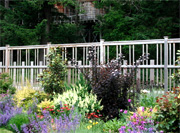
Read complete written statement
Nancy Green: Given that there are non-violent alternatives and things like changing the fencing law, and other alternatives that have been discussed, what would be the down side of trying those things for a year and seeing if they did make a change? And that way you would have tried it, and you would have made some of us at least happy to have tried a non-violent solution.
I've lived in this community now for 12 years, and the deer are a part of my life, and I would miss them if something happened to them. I have deer in my back yard that have numbers in their ears, so they now have names. So, you know, they are -- to me, they're like pets. And I wouldn't want my pet shot.
At the December 15, 2008, Board of Trustees meeting in Cayuga Heights, 11 citizens spoke out about the deer issue, 10 of whom expressed their opposition to a bait and shoot program. Here are some of their comments:
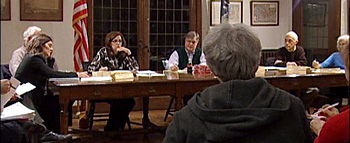 Karen Kaufmann (Cayuga Heights resident): Karen Kaufmann (Cayuga Heights resident):
I want to register my moral opposition to the bait-and-shoot killing of deer in the village. But beyond that, what I want to say tonight is to to register my strong opposition to any rush to judgment on this controversial issue. I think there's been talk at the deer committee meetings about having a decision or a recommendation ready by February or March. And I just want to urge the board and the deer committee to slow it down, to really put the time and care into this decision, that will make sure that any analysis of the problem and the solutions is based on facts and not presumptions, that there's really full opportunity for public input based on accurate information and on reliable survey tools, and that a full range of possible solutions is considered...
And I just want to say that I really believe that the lack of integrity and transparency in public decision making is a greater threat to our common good in the village than any danger presently posed by the deer. I just encourage the board and the committee to put time and care into their actions.
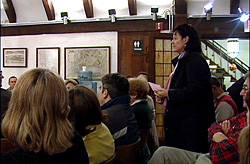 Charlene Temple (Cayuga Heights resident): Charlene Temple (Cayuga Heights resident):
I agree, I completely oppose the culling method suggested, that I've read about. My two questions are, how many car accidents are due to specific collision with deer, comparing year 2007 to 2008? And the second question is, how many cases of neighborhood-specific lyme disease have occurred due to interaction with deer ticks? Note: the Mayor referred these questions to Kate Supron, chair of the Deer Remediation Advisory Committee, who declined to answer in this forum and instead encouraged people to attend the upcoming deer committee meeting, three days later.
Mary Tabacchi, speaking for herself and her husband, Guy Tabacchi (Cayuga Heights residents):
I feel uncomfortable with the recommendations of the deer committee... I'm worried about safety, but more, I'm worried about baiting and slaughtering innocent animals. There's really no method of killing deer that's going to guarantee that they die painlessly... I worry about wounded deer running
around the neighborhood, I worry about blood, guts, etcetera. I'm not comfortable with that, it's violence... 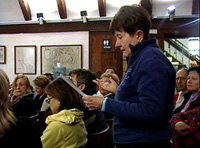
If we're worried about ticks, I don't know what we're going to do about the opossums, the raccoons, the squirrels, you know, everything else that carries ticks, so that's another thing I guess we'll have to worry about -- I'm not sure the deer carry all the ticks. So, in summary, I'm very uncomfortable -- we are very uncomfortable -- with your proposal, as members of this village. And we have lived here since 1976, 77. So, we feel very, very concerned that this is a peaceful, kind, caring neighborhood.
Sandra Stein, reading a letter from Catherine Stein (Cayuga Heights resident):
I am a resident of Cayuga Heights unable to attend today's meeting, but I would like to submit the following personal statement:
I am appalled by the proposed bait and shoot deer killing program in Cayuga Heights. I grew up in
Ithaca, and after living abroad for many years I purchased a home in Cayuga Heights in September and am in the process of moving back to Ithaca with my family. During the first weeks after taking over my house, I spent a lot of time in the garden, weeding, cleaning and getting ready for the winter. I was deeply moved by the graceful deer who calmly walked in and out of our
yard...
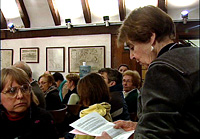 It is true that some of our garden has suffered at the mouths of these beautiful animals, but I consider their presence one small way we can connect with the natural world that we are increasingly losing touch with. The deer are indigenous to this land, and they are part of our community... It is true that some of our garden has suffered at the mouths of these beautiful animals, but I consider their presence one small way we can connect with the natural world that we are increasingly losing touch with. The deer are indigenous to this land, and they are part of our community...
In an ever more violent world, I am trying to raise my young children to respect all living beings, and to reject killing as a means of solving problems. A systematic slaughter of deer in our
neighborhood would undermine the values our family holds close, and as I believe many other Ithaca residents do also. There are practical, proven, non-violent ways to address each of the issues raised by the people who are experiencing conflict with the deer -- ways that do not involve a planned and methodical program of luring and massacring innocent animals...
I hope my neighbors and the Ithaca community will join me in opposition to this bait and shoot deer killing program. Let's work together to find a better, more peaceful approach.
Hazel Brampton (Ithaca resident): 
I've lived on Christopher Circle since 1961. We have our own herd of deer who's lived in that area with us for many years. We see them every season of the year, and they wander through our yards and eat our flowers and our hostas, and we get mad at them, and we love them at the same
time -- most of us. We also have skunks, raccoons, woodchucks and squirrels that give us trouble. And I think that we who live in the suburbs need to live and let live. They were here before we were. And I'm really pro-life, for both people and animals.
Sherene Baugher (Ithaca resident):
I'm the Director of Archaeology at Cornell University, and I live exactly a block and a half from here, so I'm right outside the village, but like some of the people here who live right outside, our local deer may be your deer too. And I want to register opposition to the slaughtering of deer. I also think that, as one of the speakers said, this should not be rushed into. I'm concerned about a lot of the statistics that are being given. For example, as an archaeologist, and my specialty is New York State, I'm working outdoors in the woods, so I know a lot about ticks and the amount of Lyme disease throughout this state, and we are one of the least likely places to get Lyme disease in the whole state...
The other thing, because I'm also affiliated with Cornell's Landscape Architecture Department.... there's a way to live in harmony and have beautiful ornamental gardens. The Cornell Plantations and [the chair of the landscape architecture department] have created a list of beautiful ornamental trees and shrubs that people can use. [The list is available at the Plantations] And I think, as much as people give all these reasons, one of the big underlying issues is that people don't like the deer eating their tulips, and their shrubs, their yews, whatever. And I think the issue is you can have the beautiful gardens, but it can also be deer friendly...
And my last point is I think the village is moving on a very, very slippery slope. Today it's the deer because they're eating the flowers, they're eating the shrubs. What about the migrating fowl, what about the Canada geese that land in people's yards, what about the wild turkeys, what about those nasty little squirrels that are eating people's bird seed, what about the groundhogs coming through, what about the raccoons? ... I think you're moving on a very, very slippery slope, and you should consider living in harmony. It's sort of like, people living in Ithaca expect it to snow. If you're living in a semi-rural area, you should expect to live with wildlife.
Lisa Duggan (Ithaca resident):
My name is Lisa Duggan and I am the coordinator for Friendship Donations. I'd like to read my written statement:
Friendship Donations receives food from all the six area supermarkets, as well as Greenstar and
Ithaca Produce, and many other places, seven days a week. We supply 25 pantries, kitchens and outreach programs in Ithaca and throughout Tompkins County, and I can say that Ithaca itself has absolutely no hunger problem and that there are numerous options for residents to go seven days a week for both hot meals and pantries. We also supply the following counties: Tioga, Chemung, Seneca, Steubing, Schuyler, and Yates.
The difference between FDN services and this proposal is that our food is very nutritious, often organic, including fresh produce, dairy, deli and breads, whereas is this program has numerous problems with the deer meat that you are proposing. The deer in this area are not eating in the wild, they are eating off plants that are covered in toxic pesticides, and unlike pesticides that are regulated for consumption on produce.
Your proposal would allow uninspected meat to be served. In another bait and shoot program, in which all the deer meat was donated to Attica prison, the entire lot was rejected, not fit for the prisoners.
Chronic Wasting Disease has been brought up as a possible public health risk, and a reason for shooting the deer. And at the same time you are saying that you are altruistically going to feed the poor with these deer, which would lead me to conclude that you are not concerned about killing the poor people that you are feeding.
I've also heard concerns about lyme disease as a reason for killing the deer, and I am from Long
Island, where our rate is more than 10 times what your rate is, and other areas throughout the state that I have looked up have been hundreds of times higher. This is, like this woman said, very minor, it's not a problem here at all.
I also have opposition to the thought of shooting in a densely populated area, where there are numerous alternatives and solutions that are humane.
|

